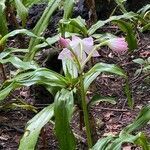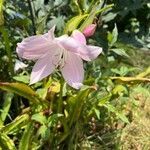Perennial geophyte, up to 0.3-1.6 m high. Leaves sheathing at base, forming a false stem up to 1.2 m tall, blades 60-120 mm wide, pale green, midrib prominent, margins smooth. Flowers 5-10, in a lax cluster, zygomorphic, widely funnel-shaped; perianth tube curved, 80-100 mm long, segments 80-100 mm long, white to delicate pink, without a dark keel, heavily scented. Flowering time Nov.-Mar. Fruit subglobose, lacking a beak.
Umbel 6-12-flowered; perigone pinkish.


